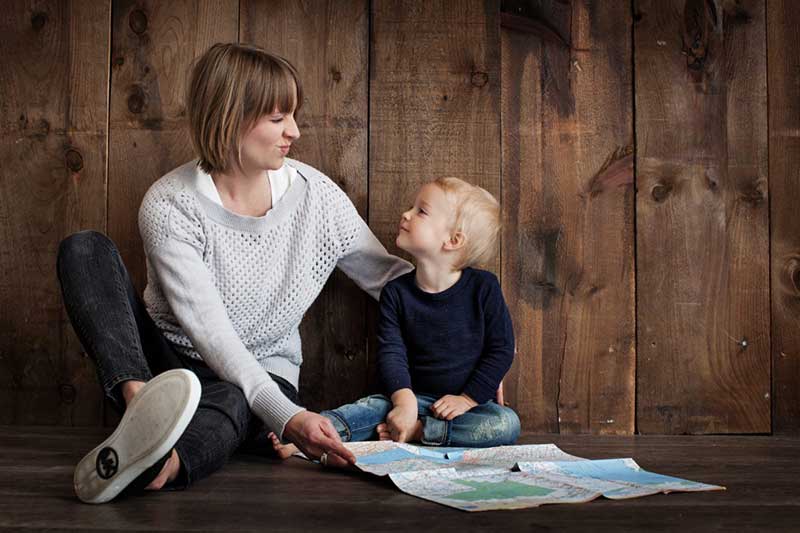Babies and toddlers
During the early years of your child’s “talking career” you may be holding a monologue for much of the time, but this is when you set the foundation for the language and there is a lot you can do to encourage your little one to start talking.

- Make talking your minority language with your child a habit from the very start – actually, why not get used to speaking your language to the bump (whether you are the mum or the dad!)
- Sing to your baby, and not only at bedtime. Articulate your words and make eye contact to create engagement.
- Repeat what your little one says. Initially it will only be random sounds and babble, but confirming the sounds is important.
- Pretend to understand the babbling and lead “discussions” – wait for an “answer” and practice taking turns.
- Have a well-stocked book shelf with children’s books in your language. Choose ones that you also like yourself, as you are going to read them several times. Get used to discussing the characters and the plot with your little one. Make it interactive from the start, although you might just get a
- When you talk, combine actions with words: wave when you say ‘goodbye’ or ‘hello’, point at things when you talk about them. Acknowledge the action when your child uses it.
- Attend play dates and play groups where your language is spoken. Being among other children speaking the language is a great motivation at any age.
- When your little one communicates, with or without intelligible words, show that you are pleased and excited.
- When your toddler says the first word, confirm it by repeating it and showing that you understand. If the word is not in your language, still confirm that you have understood.
- As the vocabulary grows, build on what your child says, e.g. when he or she says “ball” you can say “yes, it’s a yellow ball”
Small children
Keep a language diary about your little one’s new words and phrases, you think you will remember, but trust me, your child’s vocabulary will expand very quickly and soon there are too many precious talking moments not to forget some of them. Create a fun and positive environment for speaking the minority language.
- Continue being the positive role model for speaking your language – this does not mean that you should speak all the time, instead encourage two-way communication.
- Tell and discuss stories based on photo albums – make print-outs of those holiday pictures with grandparents, relatives and friends and talk about the people and places.
- Kids love hand-puppets – use them to introduce new monolingual characters into your play. Give them a “genuine” backstory to support the fact that they only understand and speak the minority language.
- Use ‘I spy’ games to expand your child’s vocabulary. You can do this in any situation – at home, when you are out and about or have to sit in a waiting room (use a magazine if you run out of words).
- Engage in role play with you little one. Let him or her take the lead and immerse yourself in their imaginary world. Help with new words which are needed to move the story forward. Ask open ended questions.
- Find that something which is really motivating for your child. What will make your little daughter or son really want to say something? In our case it was a monolingual pet, Pricken – the Swedish-speaking kitten.
- Use free online video call apps to catch up with grandma and grandpa or any other relative or friend who only speaks the minority language.
- Introduce the terms ‘mummy says’ and ‘daddy says’ (or whoever speaks the language in question) to help distinguish words from different languages. E.g. if your child uses a different language when pointing out a specific thing, confirm that it is right and give the word in your language.
- Engage your kids in discussions in everyday situations, ask for their opinion or advice. Ask why so that they can expand on their answers. And do always answer their “Why?” questions!
- Have patience, wait, relax. Don’t rush your little one or offer the word too quickly. Allow him or her to find the word or to come up with a different expression.
School-age children
Starting school in the majority language is one of the most crucial stages in a bilingual child’s language development. The minority language may have been dominant in the home until now, but the balance will inevitably tip in favour of the majority language, so your continuing support is vital.
- Stick to speaking your language with your child – don’t make a big deal of situations where he or she uses the majority language. Remember that they have spent the whole day immersed in it. However, always stick to your language in these situations.
- Visits to where the minority language is spoken in the community is arguably the most effective way of encouraging your child to speak it. Being fully immersed in the language through people and media can give your child a real language boost.
- If the majority language is becoming more dominant in the family, e.g. children use it as the language they speak with each other, try to introduce ‘minority-language-only’ days or situations. Depending on what spurs your kids on, you could have incentives for sticking to the right language.
- Treasure hunts are always a popular game. If your child can already read, this will also help with the reading. If you are the one reading the hints, make it a rule that you only answer questions in the minority language.
- Play board games with read-out instructions or questions in the minority language. If you can’t find them where you live, suggest them as birthday presents that the grandparents can buy!
- Small children are eager to help if we let them. If you have more than one child, ask the older siblings for help with teaching their little sister or brother your language.
- Continue singing! Find familiar songs that your child has sung at school and sing them together in the minority language.
- If you are the majority language speaker, ask your child to teach you something in the minority language. Kids love being in the “teacher” role with their parents.
- Leave the room when your child gets going on a Skype call in the minority language. Kids are sometimes inhibited by parents, especially if they are a bit unsure how to express themselves, and perform better on their own.
- Always listen – stop and take the time to listen to what your child has to say. They are small for a very short time.
Teenagers and young adults
Becoming a teenager is another phase when the minority language might lose ground. Peer pressure can lead to your child avoiding using the minority language. Maybe it is not the done thing, perhaps your teen just wants to be like everyone else. Your support is essential so your soon-to-be-adult child can maintain the minority language. They will thank you later!
- While a small child cannot appreciate all the advantages bilingualism brings with it, with a teenager you can discuss for example the benefits of knowing more than one language when you look for a job.
- Money is often a high priority at this age, remind them that if they keep up their language skills this will most likely lead to a higher salary later on.
- Being able to speak another language gives your teenager a bigger choice of schools – maybe they would want to study abroad at some point?
- Find ways of making a connection between their hobbies and the minority language – could you find a fellow enthusiast they could connect with over Skype?
- Look for interesting films in the minority language and watch them together.
- Travelling broadens the mind and deepens the language skills – if possible, help your youngster to take a solo trip to somewhere where he will have to use the minority language. I would start with relatives or friends and take it from there.
- Are there summer camps your teenager could attend, preferably in a country where your language is the majority one? Speaking the minority language with other teenagers will give the language a real lift.
- To support the written form (and so continue increasing the vocabulary) always message in the minority language with your teenager. Even if you get an answer in another language, continue using yours, as it is beneficial for him or her to regularly see the written word.
- A language course in the minority language can sometimes be the most effective way of reinforcing it. Check out the teaching style of the course in advance to make sure it will be suitable for your teen.
- You are the most important role model for speaking your language. Show pride in the language and the culture it represents. Speak it at every opportunity both inside and outside the home. Be the confident bilingual you want your teen to be.
I hope these tips are helpful to you on your journey to raise a confident bilingual!

 Persian
Persian  English
English  Arabic
Arabic 





